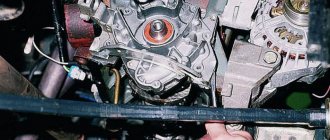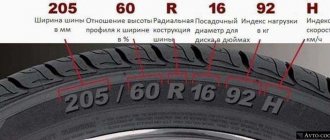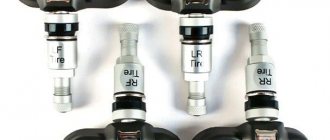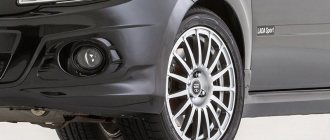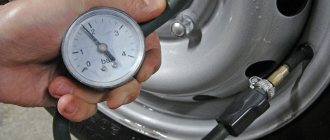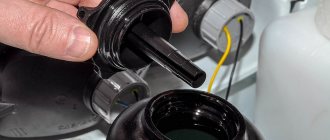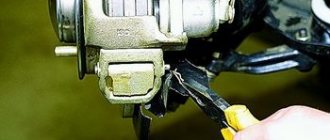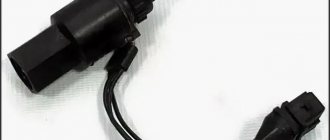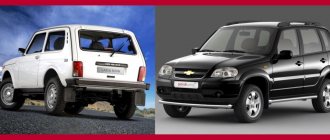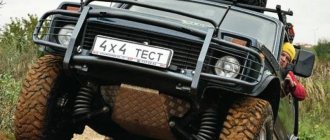Why measure tire pressure on Niva Chevrolet
Before you start measuring tire pressure, you need to decide on the units of pressure measurement. The most common are bar and atmosphere (atm.). Many people consider them identical, but this is not entirely true. If we take one normal atmosphere (760 mm Hg) as 1, then 1 bar will be 1.0133 atm. The difference of less than 2% is caused by the peculiarity of the mmHg conversion. Art. to Pascals in the SI system. All modern pressure gauges are marked in bars or atmospheres.
Timely monitoring of tire pressure affects:
- stability of straight motion;
- maximum braking distance of a car;
- stability and safety of control in extreme conditions;
- uniform tire tread wear;
- eliminates damage to tire sidewalls and cords;
- reduces fuel consumption at all speeds.
The pressure in Niva Chevrolet tires may be too low or too high . The behavior of the car on the road differs from this value as follows.
Important! The nominal level for wheels with landing radius R15, R16 is taken to be the factory setting of 1.9 bar.
Blood pressure is higher than normal . The car's ride becomes harsher, the contact patch with the road surface decreases, and directional stability deteriorates. The braking distance increases greatly, especially on wet or slippery surfaces. Characteristic bald spots appear on the tread in the middle of the wheel. An overinflated wheel is much easier to damage, and strong impacts are transmitted to the disc and suspension elements.
Underinflated wheels increase the effort on the steering wheel of the car and significantly increase gas mileage. The behavior of the SUV on hard surfaces becomes slack, the car yaws and floats on the road at high speed. The tread wears out from the edges of the tire, and the sidewall becomes cracked. Such a wheel cannot protect the disc from a strong impact when falling into a hole.
Advice. If the pressure on all wheels is not uniform, the car will pull towards the flat tire.
The causes of flat tires are universal for all brands of cars - punctures, damage to the beads, curvature of the wheel rim, air leakage through the valve, drying out and loss of tightness of tires due to age.
Why is it necessary to control?
Reduced or increased air content leads to a change in the contact surface of the tires with the road surface. This leads to various consequences.
For high blood pressure:
- road grip decreases
- road stability decreases
- tire tread wears off unevenly, more in the middle
- the shock-absorbing properties of the wheel are reduced
- the risk of damaging the tires when falling into a hole increases
- braking distance increases
At low pressure:
- increased contact area with asphalt
- fuel consumption increases
- the tread wears out faster and unevenly, more at the edges
- car control deteriorates
- decreased stability when turning and changing lanes at high speed
- the chance of tire and rim damage increases when a wheel falls into a hole
The greatest danger comes from different pressures in all wheels. While driving, the vehicle “steers” towards the wheel with the lowest value.
Instruments and methods for measuring pressure
Chevy Niva tire pressure measurements are carried out with any mechanical or electronic pressure gauge:
- Mechanical dial pressure gauges are considered simple and unpretentious devices. The operating principle is based on a cylinder with a piston and a spring, and an arrow associated with it. Measuring range from 0.1 bar to 8 bar. The disadvantage of pointer instruments is the low measurement accuracy and dependence on the ambient temperature (underestimates readings in winter). Pros: reliable and cheap, do not require a power source.
- Electronic or digital pressure gauges . Modern high-precision instruments. Models from well-known manufacturers have minimal errors. Equally accurate in winter and summer. Cons: high price, less reliability.
Important! Measurements are made with a stationary vehicle and cold tires. After driving, you should let the car sit for 2-3 hours in summer or up to half an hour in winter. The correct order of measurements is indicated in the instructions for the pressure gauge.
The disk-tire system is not completely sealed, especially on off-road vehicles , which include the Chevrolet Niva. Air under pressure will always find a place to escape, so such pressure checks should become regular, and not 1-2 times a year when changing tires. The optimal mode is to check once every 2-3 weeks, before a long trip and after off-road trips.
Advice. Many drivers forget about the condition of the spare tire and only remember it when changing it. A deflated spare wheel will not help if a tire punctures, and you will only be able to drive a deflated wheel for a few kilometers, after which the tire will most likely have to be thrown away.
Measuring methods
It is impossible to determine the amount of air in tires without special instruments. Outwardly, it turns out to notice only some deformations, the cause of which was incorrect pressure. As a result, some depression may appear on the rubber itself and the tread pattern may change.
You can measure tire pressure on a Chevrolet Niva only using pressure gauges. There are two types of such devices:
- mechanical (switch);
- electronic.
Electronic pressure gauge for cars
The percentage of error for mechanical pressure gauges is higher, but not significant. In everyday life, they can be used with the same success as their electronic counterparts. Electric pressure gauges provide the most accurate results. The error indicator in this case is no more than 0.05 bar. Today this is the most accurate device for measuring tire pressure not only on Niva, but also on other cars.
It should also be noted that in winter the tire pressure level can be more or less accurately measured only with an electronic pressure gauge.
Off-road wheels on Chevy Niva
The difference between special off-road tires and all-season tires lies in a different power structure and standard size. Among the manufacturers of mud tires for Chevrolet Niva, BFGoodrich, Cordiant, Forvard, Federal Mogul and others have proven themselves well. They produce tires in sizes 215/65/R15, 215/75/R15, 225/65/R15, which fit on the Niva with minimal modifications to the standard wheel arches. Tread type M/T or A/T.
Off-road tires are distinguished by increased lugs and a reinforced tire sidewall . In addition, it is elastic and works well when deflated to a minimum. The working pressure of mud tires directly depends on the type of terrain being overcome. On rocky soils it is recommended to pump up to 2.3-2.5 atmospheres. This increases the ground clearance and traction properties of the tires. On muddy ground, sand or snow, the pressure is released to 0.8-1 bar. The tires roll well and allow you to overcome very difficult areas.
Chevrolet Niva tire pressure according to the passport
For cars such as the Chevrolet Niva, maintaining this parameter is especially important.
The center of gravity of this car is high, and the car cannot be called stable, especially during emergency maneuvers. It is impossible to measure the degree of air compression in a tire without special measuring instruments. Mechanical pressure gauge
Pressure gauges are used for these purposes. They are divided into two categories that differ structurally:
- Mechanical pressure gauge. A device for measuring tire pressure, having a mechanical drive and a dial indicator. Has a significant degree of error, long service life, does not require a power source.
- Electronic pressure gauge. Electronic type device with a screen for displaying measurement data. It is powered by an internal power source; when used correctly, the error tends to zero.
Important: The error of devices of the first type is greater in winter than in summer due to temperature deformations of mechanical parts. In cold weather, it is recommended to use only to get to the garage or service station. The disadvantage of electronic pressure gauges is that the battery can run out at the most inopportune moment.
Electronic pressure gauge for car tires
In order not to endanger your life and the lives of others, you need to check the tire pressure before each trip, especially over long distances. The sequence of actions is as follows:
- We check the readings using a pressure gauge as indicated in the instructions for it. Tires should not be warm. The car must sit for three hours.
- We compare the readings with the data in the table of permissible tire pressure for the Niva 21214 car.
- After 30-40 minutes, we repeat the measurement, and if the readings become low, it means there is a puncture. Keeping the data at the same level indicates that you can leave.
Recommendation: After the end of the trip, another measurement is taken 2.5-3 hours later. This requirement is optional. However, when you drive the next day, you won't be surprised by a flat tire. All wheels are checked, including the spare.
Tire Niva
To always know what pressure gauge readings are considered normal, print out a table of acceptable readings and carry it in the glove compartment (if the metal plate on the car body is missing or has become unusable), and the pressure gauge in the trunk. In the cold season, the road surface is slippery and the tires are less elastic. Therefore, in winter, tire pressure should be lower than in summer. The permissible run-up is 0.2-0.3 bar.
Due to this, the area of the contact patch increases and the grip on the road increases. The standard pressure in Chevrolet Niva tires depends on the parameters of the ramp indicated on its sides.
The table shows data for 205/75 R15, 205/70 R15 and 215/65 R16. These data are identical for the Chevrolet Niva 21214 and Niva 21213 models.
In some emergency cases, it is possible to make the injection rate lower than recommended.
So, the pressure in the tires of a Niva Chevrolet in winter can be reduced to 1.2-1.5 atm if you get stuck in the snow. This will allow you to get out, but immediately after leaving on solid ground, the indicators must be brought to normal. The Chevrolet Niva, although an SUV, is not an all-terrain vehicle, and can get stuck not only in winter. What pressure to set depends on the type and degree of tread wear.
If you do not adhere to the described operating requirements, the following will happen:
- Increased load on chassis parts will lead to premature wear and failure.
- Fuel consumption will increase due to the fact that the flat tire has a larger contact area. The protector, having opened, prevents movement. The engine will need to develop more power.
- The tires will wear out quickly. The reason for this is the increased contact patch with the road surface. By the way, lateral abrasion indicates that the tire is flat, and it is necessary to urgently take measurements and eliminate the cause.
- The risk of getting into an accident increases significantly, especially if you overinflate your tires in winter.
But if you monitor the amount of air in the slopes, the Chevrolet Niva will always remain a safe car with outstanding cross-country characteristics.
The importance of maintaining the correct pressure in Chevrolet Niva tires is one of the most underestimated parameters by car owners. This is important because the pressure maintains a range of performance characteristics:
- car control stability;
- ride stability;
- braking distance within the design;
- specified trajectory of movement;
- uniform wear of the treadmill, due to which the service life of the tires is maintained at the proper level;
- integrity of the side surfaces;
- volumes of fuel consumption not higher than those specified in production.
The Niva manufacturer recommends that the pressure on both the front and rear axles reach 1.9 bar. The recommendation applies to the sizes of 15-inch tubeless tires 205/70, 205/75 and 16-inch 215/65.
In the case of off-road driving, factory recommendations allow the indicator to be reduced to one and a half bar. In some cases, car owners themselves increase the pressure to 2 or 2.2 bar for driving on the highway. The manufacturer indicates that pressure above two makes the ride harsher and less comfortable.
Also interesting: “PKK Saktagan” | ALGA 4×4 Chassis
Tire pressure is measured using special devices and at specified intervals. The main measuring device is a pressure gauge. There are two categories of this device:
- mechanical;
- electronic.
The first ones are distinguished by the fact that they have a mechanical drive in combination with a dial indicator. The disadvantage is the rather high level of error, which increases in the cold season. This is due to temperature deformation.
In connection with this, mechanical pressure gauges are used in the cold only as an aid until the opportunity to visit a service station arises.
But this disadvantage is offset by the long service life and the absence of the need for a power source.
The second category of devices is powered by a battery that is charged through a network connection. The main drawback is the ability of the battery to die at the most inopportune moment. Thanks to a more complex device, such a pressure gauge has minimal error.
The data is displayed on a screen similar to the display of other electronic devices.
Checking tire pressure before each long trip is a mandatory step to ensure the safe operation of the vehicle.
Do the necessary actions in a certain sequence:
- let the car sit for at least three hours;
- check that the tires are cold;
- connect the pressure gauge and take measurements as indicated in the instructions for it;
- check the result with the table of acceptable values;
- recheck the data after a half-hour pause.
Evidence of a puncture will be a decrease in readings between two measurements. The absence of any changes indicates that the situation is normal.
Experts recommend checking the pressure after driving. This must be done two and a half or three hours after stopping. Thanks to this additional measurement, you can eliminate the possibility of a puncture formed during the trip. It is necessary to measure data not only on the installed tires, but also on the one that is used as a spare.
Normal pressure indicators for tires installed on a Chevrolet Niva crossover depend on their size, weather conditions and type of road surface.
Service station experts recommend installing tires on a Chevrolet Niva strictly according to the season, thereby eliminating universal, all-season tires. When operating a machine in high positive or negative temperatures, the rubber composition changes its properties, thereby deteriorating the technical characteristics.
Before purchasing tires for a Chevrolet Niva yourself, get advice from specialists regarding the compatibility of tires with your car model.
The adhesion spot in winter should be larger than in summer. That is why the tire pressure should be reduced. The larger the grip area, the less likely it is to have an accident on a slippery road. For the accuracy of the indicators, it is necessary to take these indicators correctly. This is done as follows:
- First you need to check that the tires are not warmed up.
- Three hours before taking measurements, you should not use the car for its intended purpose.
- Measurements must be taken on all four wheels of the vehicle.
Only if the correct conditions are met can we assume that the tire pressure in a Chevrolet Niva is determined correctly. Of course, all owners of this brand are interested in the exact air coefficient in their tires. You need to know that the Chevrolet Niva with different tires has excellent measurements, namely:
- A Chevrolet Niva with 205/75 R15 wheels has a pressure in the front wheels of 2.1/30 atm./psi. The rear tires should have the same data;
- a model with tire size 215/65 R16 has rear performance of 2.2-31 atm/psi and front performance of 2.2/31.
A pressure gauge is used to measure tire pressure.
The dial pressure gauge is most often used, as it is the most reliable and cheapest. It works on the basis of a special spring. The same spring is the “Achilles heel” of the pressure gauge; if the device is hit or dropped, it can break.
A mechanical pressure gauge is more reliable. It is based on a cylindrical spring. However, this pressure gauge shows the greatest measurement errors.
An electronic pressure gauge has the greatest accuracy. True, very cheap devices lack this quality. Like any electronics, it is less reliable compared to its mechanical counterparts.
Often the driver remembers the tire pressure only 2 times a year - when changing tires at a tire shop before the next summer or winter season.
However, the wheel is not a completely sealed device and over time, depending on the degree of wear of the rubber, air may escape. Ideally, you should check the amount of air before each trip. But the most optimal control mode would be to check once every 2-3 weeks and before long trips.
| Tire type | Front, atm | Rear, atm |
| 205/70 R15 | 2.1 | 2.1 |
| 205/75 R15 | 2.1 | 2.1 |
| 215/65 R16 | 2.2 | 2.2 |
Niva Chevrolet and low pressure wheels
Low-pressure tires or arched tires are highly specialized tires that are designed primarily for constant use in severe off-road conditions, in swampy areas, and deep snow. They differ from ordinary off-road wheels in their width, light weight, and the normal pressure in such wheels is 0.5-0.7 bar.
It is impossible to install low-pressure tires on a standard Chevrolet Niva without modifying the car . You will need to lift the car and suspension, change the main pairs, strengthen the suspension elements, and install a pumping system. Such tuning turns the Niva into an excellent rogue on any terrain.
Disadvantages of low pressure tires in everyday use:
- short wheel life;
- reduction of maximum speed;
- deterioration in controllability;
- decreased reliability of the vehicle transmission;
- transfer of the car to the section of self-propelled vehicles;
- increased gasoline consumption.
How the pressure sensor works, how to turn it off on a Chevrolet Niva
The main task of the controller is to monitor changes in air pressure in the tire and transmit data online to the electronic control unit. The latter compares the indicators with the programmed ones and informs the driver about a possible malfunction. Most often, this is a sound signal combined with light flickering.
Principle of operation
- A pressure measuring sensor is installed on the inside of the tire. This must be done with the wheel lowered.
- After activation, the controller measures the pressure every 3 seconds and sends the data to the ECU. Bluetooth technology is used as a means of communication.
- The electronic control unit analyzes the obtained indicators for each of the wheels and compares them with the specified parameters.
- The end result can be duplicated on a smartphone if a special application is installed on the latter.
How to disable pressure sensors
There is no such thing as deactivating a sensor for the reason that it is impossible, since the absence of equipment must be registered at the system level. In case of unauthorized deactivation of the controller, “Error” is displayed on the dashboard.
Some car owners practice physically dismantling controllers in a service station. Do not try to do this on your own, as unprofessional intervention does not guarantee full functionality of the electronic control unit.
Source: kolesospec.ru
Consequences of incorrect tire pressure
Most car owners should remember the manufacturer's recommended tire pressure value for Chevrolet Niva - 1.9 bar . This is a normal value that should be used as a starting point when making adjustments up or down. Minor deviations will not lead to adverse consequences. There may be an increase in fuel consumption or slight discomfort in the car interior.
But deviations from the norm of 0.5 atmospheres or more already have a serious impact on safety and controllability and cause increased tire wear. To avoid this, it is recommended to always have a high-quality pressure gauge in your car and regularly measure the pressure in all wheels, including the spare tire.
Relieving pressure correctly
In order for the readings to be accurate, you need to remove the pressure correctly. This should be done this way:
- tires must be unheated;
- for the last 3 hours before measurement, the car should be at rest or drive no more than 1.5 kilometers;
- Measurements must be taken on all four wheels and the spare wheel.
Only in this case can the readings from the pressure gauge be considered correct.
Table of values for the required tire pressure level for the Chevrolet Niva:
| Automobile model | Years of production | Tire size | Front tire pressure (atm./psi) | Rear tire pressure (atm./psi) |
| Chevrolet Niva | 2004—2014 | 205/75 R15 | 2,1/30 | 2,1/30 |
| Chevrolet Niva | 2004—2014 | 205/70 R15 | 2,1/30 | 2,1/30 |
| Chevrolet Niva | 2004—2014 | 215/65 R16 | 2,2/31 | 2,2/31 |
The pressure standards for Niva wheels 2121 or 21214 must be indicated on a special metal plate. As a rule, it is attached to the door on the driver's seat side. If for some reason there is none, you can look at the data online. But in this case, it is better to take into account the readings only approximately.
You should also pay attention to the fact that the amount of air in the rear tires should be about 0.3-0.5 bar more. This is due to the fact that the load on the rear axle of the wheel is always greater than on the front.
Checking car tire pressure
